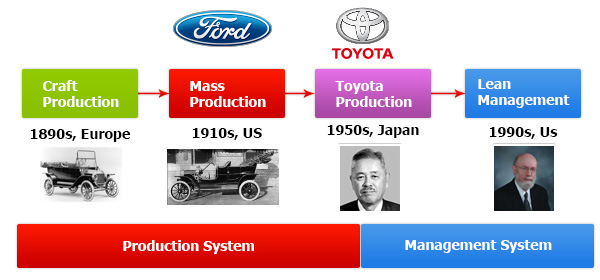Have you ever heard of the phrases “lean thinking”, “lean principles” or “lean six sigma”? Lean principles help to examine business processes and focus on minimizing unnecessary costs, reducing waste and improving inefficient procedures. Recently Robert Logemann published an article in CFO.com titled ”Want to go lean, first understands what it means” where he stated there are a lot of misconceptions about it and it has been thrown around in buzzword-packed phrases in meetings such as “we need to embrace a model that’s Lean,” or write a book and call it “the lean startup.” And Mr. Logemann said the problem is that “Lean” operations follow a well-defined underlying theory and set of principles, but many people are so used to hearing the term used as a buzzword that they don’t realize it refers to an actual philosophy.
“When properly understood, implemented, and executed, the philosophy that underlies the principle can be of enormous value,” said Mr. Logemann.
In 2008 researchers partnered with Boeing’s Ground-Based Missile Defense (GMD) program to conduct a study on the ROI of using the lean approach for a project, their results concluded that lean initiatives led to :
- 45% reduction in cycle time.
- 28 % reduction in labor costs.
- 60% reduction in time lost due to anomalies.
- 24% reduction in Non-Conformances.
Mr. Logemann also points out that by its actual definition ‘lean” commonly refers to any operations system that can reduce waste without compromising quality or productivity. But it is easy to misinterpret crucial aspects of the philosophy when you only know the buzzword or the definition that was mentioned above. So Mr. Logemann goes into covering a few areas that he thinks are still the biggest misconceptions that professionals have about the Lean thinking approach.
Myth #1: Lean Principles Apply Only to Manufacturing organizations
 So although lean thinking did originally come from the manufacturing world it is not exclusively tied it only. Mr. Logemann states that “people often conflate Lean — a non-industry-specific and more adaptable phrase coined by researcher Jim Womack — with the Toyota Production System (TPS), which was specific to the auto manufacturer.” TPS was an integrated, socio-technical approach that’s purpose was to smooth out inconsistencies, reduce waste, and minimize stresses in both the manufacturing process and the business day to day interactions with suppliers and consumers. The idea behind the TPS was to develop an approach now known as lean management, that was (a universally applicable system) flexible and efficient, but not bogged down by its productivity goals. During the 1970s when the American car companies were churning out gas guzzlers that not selling very well. In 1979, Dr. James Womack joined an MIT team to study the Japanese auto industry to find out why companies like Toyota were surging ahead as GM and Ford retreated. And he found out wasn’t about the Japanese auto industry as a whole; that it was the Toyota Production System (TPS) and the broader Toyota management system. Dr. Womack realized and drew heavily on the TPS approach (lean production) that continually created more value for customers with fewer resources when he created the lean philosophy. But the two styles are not completely identical. Mr. Logemann states that “lean is more generic, comprehensive, and adaptable to interests outside of manufacturing. Womack’s approach teaches businesses to continually investigate what their companies’ and customers value, and then provide that value efficiently and effectively.”
So although lean thinking did originally come from the manufacturing world it is not exclusively tied it only. Mr. Logemann states that “people often conflate Lean — a non-industry-specific and more adaptable phrase coined by researcher Jim Womack — with the Toyota Production System (TPS), which was specific to the auto manufacturer.” TPS was an integrated, socio-technical approach that’s purpose was to smooth out inconsistencies, reduce waste, and minimize stresses in both the manufacturing process and the business day to day interactions with suppliers and consumers. The idea behind the TPS was to develop an approach now known as lean management, that was (a universally applicable system) flexible and efficient, but not bogged down by its productivity goals. During the 1970s when the American car companies were churning out gas guzzlers that not selling very well. In 1979, Dr. James Womack joined an MIT team to study the Japanese auto industry to find out why companies like Toyota were surging ahead as GM and Ford retreated. And he found out wasn’t about the Japanese auto industry as a whole; that it was the Toyota Production System (TPS) and the broader Toyota management system. Dr. Womack realized and drew heavily on the TPS approach (lean production) that continually created more value for customers with fewer resources when he created the lean philosophy. But the two styles are not completely identical. Mr. Logemann states that “lean is more generic, comprehensive, and adaptable to interests outside of manufacturing. Womack’s approach teaches businesses to continually investigate what their companies’ and customers value, and then provide that value efficiently and effectively.”
Business leaders who implement a lean approach must continuously strive to improve their quality measures, minimize waste, and tweak their set processes to increase efficiency throughout an organization. The power of the lean management discipline encapsulates:
- Putting customers first by truly understanding what they need and then delivering it efficiently
- Enabling workers to contribute to their fullest potential
- Constantly searching for better ways of working and giving meaning to work by connecting a company’s strategy and goals in a clear, coherent way across the organization
Now although the manufacturing industry was the first to invent and benefit from lean thinking, it is not the only use case vertical sector that it can be applied to. Back in 2014 the management consulting firm Mckinsey and co. wrote a research article titled “Next frontiers of lean” points out that “lean operating principles are being applied to service industries that had not previously thought of themselves as having factory-like characteristics.” Such as financial services, healthcare, airlines, retail banking, restaurants are industries that can and already have benefited from its implementation. The Mckinsey and Co. researchers further explain that improved technology will be a critical factor in the proliferation of Lean approaches across all sectors.
In the article they state “new analytical tools and new ways of looking at customers are making it possible, with greater precision than ever before, to learn what they truly value. The implications are profound because one of the primary constraints on the ability to design a perfect lean system in any operating environment has always been the challenge of understanding customer value, lean’s ultimate ‘North Star.’ ” Other real-world trials, have been tested and resulted in how lean thinking can have a meaningful and positive impact on the field beyond the manufacturing scope. Back in 2010 some researchers from the University of Wisconsin-Madison conducted a study found that when hospitals adopted a Lean approach to emergency room management, they tended to see an improvement in patient care quality, decreases in length of stay and wait times, and a significant drop in the number of patients who left the waiting room without being seen. The philosophy’s initial results in the medical and healthcare environments prove that it should not be limited to only the manufacturing sector.
Myth #2: Lean Is a Quick Fix
When someone says the phrase such as “we need to Lean out that process!” this may sound good during a corporate address or conference call, but they are underselling the time and effort that implementing the philosophy requires.
Lean management is not a short term cost-reduction effort, but more a way of life or culture. If businesses want to incorporate the approach into their day-to-day operations, they must willing to dedicate themselves to engineering a completely new business system that can meet the philosophy’s principles in a manner that works for the specific company. Meaning there is no one-size-fits-all approach. And management cannot simply announce the switch to a lean approach and expect the workers to follow along as if the change were a corporate initiative. Rather the transition must be undertaken as a cultural shift or movement, requiring employee buy-in and encourage them to actively search for areas of improvement within their positions and wheelhouse. Meaning change takes time and requires a vision. If not the leader’s efforts can end up falling short. In 2017 a leadership article titled “Changing Company Culture Requires a Movement, Not a Mandate” was published in the Harvard Business Review and the author stated, “ to harness people’s full, lasting commitment, they must feel a deep desire, and even responsibility, to change.” It is so important to keep that in mind, too, that a Lean transformation is not something that can be accomplished in a 1-, 2-, or even 3-year period.
It should be approached instead from the point of view as a never-ending journey that strives for both continuous improvement and the continual elimination of non-value-added activities and waste. The change will require full buy-in from everyone at every level of the business.
Myth #3: Lean = Six Sigma
The 3rd myth that Mr. Logemann would like to bust, no pun intended is “Lean and Six Sigma are not synonymous terms.” In fact, Six Sigma is just one of the tools in the Lean toolbox. Where Lean is a broad philosophy, Six Sigma is a structured methodology that guides businesses through process improvements and helps them make the most of their current resources. It’s an efficiency tool, but not a guiding philosophy.
Lean is more than a business jargon or buzzword. So, before you dismiss it as just another management fad, take the time to understand the philosophy and gain a sense of why it earned its popularity in the first place. You may find that the effort pays off.










